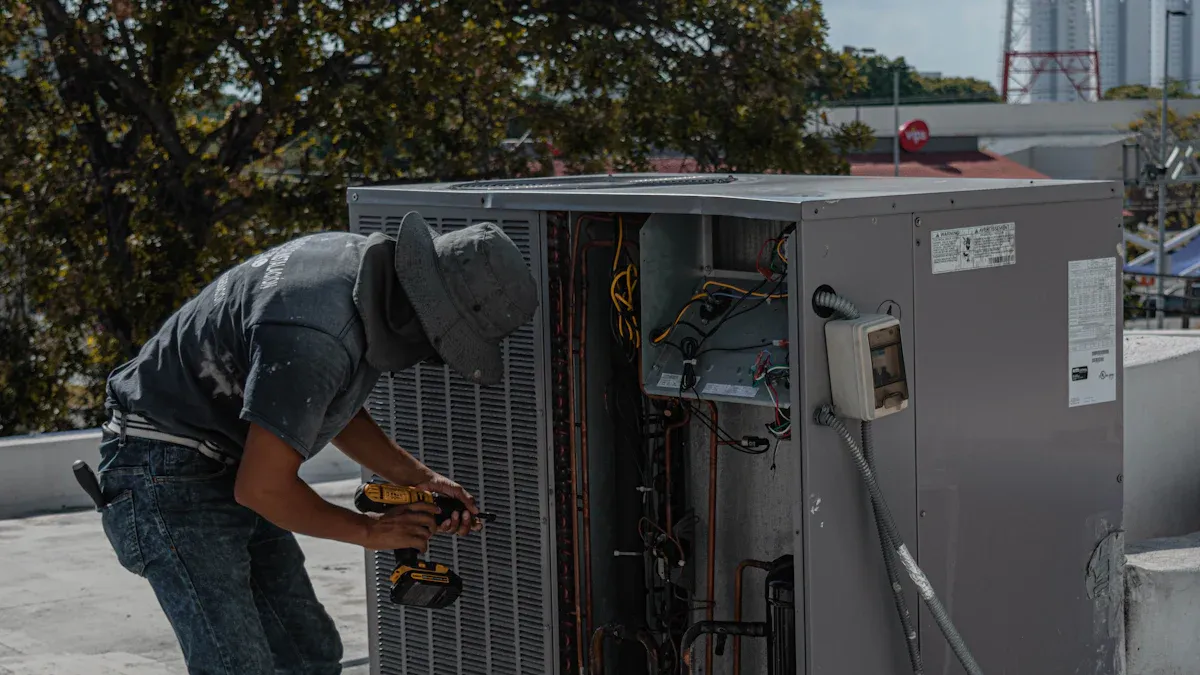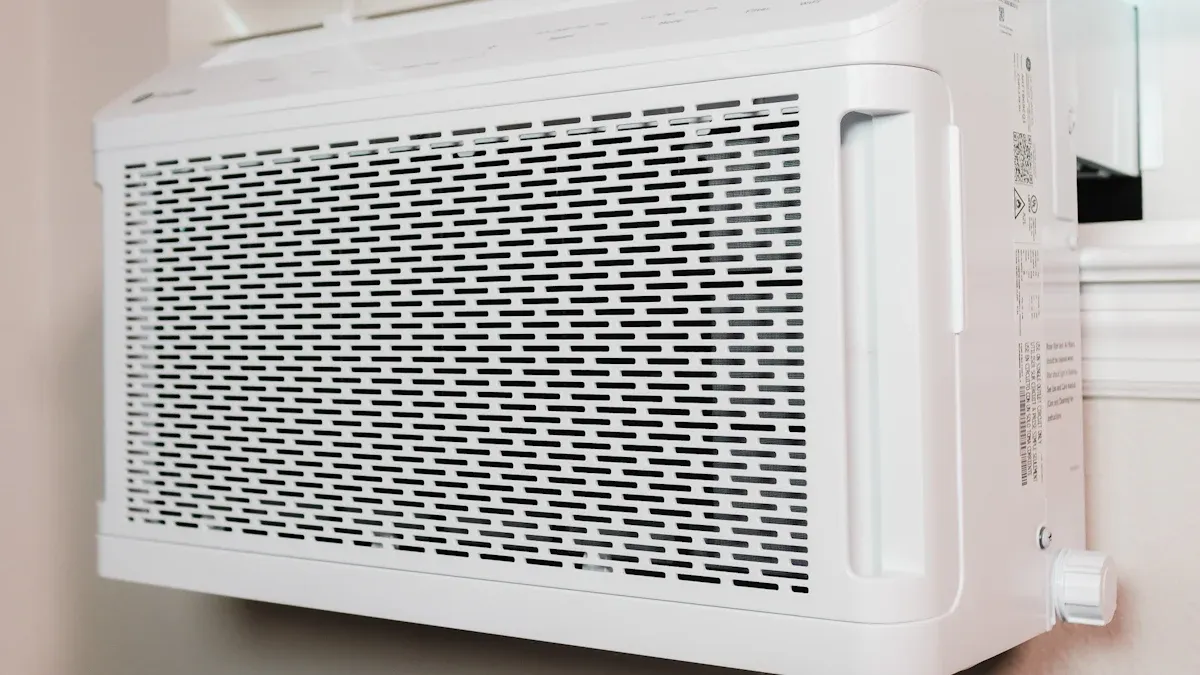Air-Cooled Condensing Units Explained: Benefits and Uses

An Air Cooled Condensing Unit is an important part of cooling systems. It moves heat from the refrigerant to the air around it, helping to keep temperatures steady and cool. Fans blow air over coils, where the refrigerant loses heat and turns into liquid. This process makes cooling work well in many places.
Here are some key numbers:
Cooling Power: 17,920 BTUH
Efficiency Rating: 7.6
Compressor Running Amps: 9.6
Compressor Start Amps: 58
Minimum Circuit Amps: 15
Max Overload Protection: 20
Fan Amps: 9
Heater Amps: 23
These numbers show how dependable and effective an Air Cooled Condensing Unit is for cooling.
Key Takeaways
Air-cooled units cool refrigerants by moving heat into the air.
They are important for air conditioning and keeping things cold.
These units save energy and money by using less electricity.
They provide steady cooling without raising power bills too much.
A big plus is low upkeep; clean fans and coils often.
This keeps them working well and avoids many repairs.
Air-cooled units are eco-friendly, using less water and green refrigerants.
This helps lower pollution and is better for the planet.
They work in many places like homes, offices, and data centers.
What Is an Air-Cooled Condensing Unit?
Definition and Key Features
An air cooled condensing unit is a key part of cooling systems. It moves heat from the refrigerant to the air, keeping temperatures steady. These units are used in air conditioners, refrigerators, and industrial cooling systems.
Here are some important features:
Compact Design: These units are small and simple to set up.
Fan Mechanism: A fan pushes air over coils to cool the refrigerant.
Durability: They are made to handle outdoor weather and last long.
Energy Efficiency: Many models save energy while working well.
These features make them a great choice for many industries. They are reliable, affordable, and easy to care for.
Role in Cooling and Refrigeration
The main job of an air cooled condensing unit is to help with cooling. The refrigerant absorbs heat and turns into a gas. The unit cools this gas by sending it through coils. The fan blows air over the coils, making the refrigerant lose heat and become liquid again.
This process keeps air conditioners and refrigerators at the right temperature. These units are often found in homes, businesses, and factories. They help cooling systems work well, even in tough conditions.
Tip: Clean the fan and coils often to keep your unit working longer and better.
How Does an Air-Cooled Condenser Work?

The Heat Exchange Process
An air cooled condenser helps cooling systems by moving heat away. First, the refrigerant takes in heat from the air in the evaporator. This heat makes the refrigerant turn into gas. The gas then goes to the compressor, where it gets hotter and under more pressure.
After that, the refrigerant moves into the condenser coils. Fans blow air over the coils, letting the heat escape into the air. As the refrigerant cools down, it turns back into liquid. This liquid refrigerant goes back into the system to start the process again. This cycle keeps the cooling system working and keeps temperatures steady.
Note: Clean the coils and fans often to help the system work better.
Components and Their Functions
Each part of an air cooled condenser has a job to do. Here are the main parts and what they do:
Compressor: It makes the refrigerant gas hotter and increases its pressure.
Condenser Coils: These coils let the refrigerant release heat and turn into liquid.
Fans: They blow air over the coils to remove heat.
Refrigerant: This fluid carries heat and helps with the cooling process.
These parts work together to keep the system running well. Knowing how they work can help you take care of your cooling system and make it last longer.
Benefits of Air-Cooled Condensing Units
Energy Efficiency and Cost-Effectiveness
An air cooled condensing unit works efficiently, saving energy and money. These units use fans to cool the refrigerant, needing less energy than water-cooled systems. This makes them great for home air conditioning and split systems. They keep cooling steady while keeping electricity costs low.
Some models have advanced features to save even more energy. For example, variable-speed fans change airflow based on cooling needs. This helps the unit work well without wasting power. Choosing an air cooled condenser means getting good cooling at an affordable price.
Tip: Pick units with high energy-efficiency ratings to save more over time.
Low Maintenance Requirements
Air cooled condensing units are simple to care for, making them a smart choice for homes and businesses. Unlike water-cooled systems, they don’t need constant water or complex plumbing. Just clean the fan and coils often to keep them working well.
Their basic design lowers the chance of mechanical problems. You won’t need frequent repairs or expensive replacements. This makes sure your cooling system works with little effort.
Note: Plan regular check-ups to find problems early and make your unit last longer.
Environmental Sustainability
Air cooled condensing units help the environment by using less water and energy. They don’t need water for cooling, which saves local water supplies. Many units also use eco-friendly refrigerants that cut down on harmful emissions.
By using an air cooled condenser, you choose a greener cooling option. These systems meet today’s environmental rules, making them a smart pick for homes and split systems. You can stay cool while lowering your carbon footprint.
Callout: Choose units with energy-saving features and eco-friendly refrigerants to help the planet.
Uses of Air-Cooled Condensing Units
Cooling for Homes
Air-cooled condensing units are important for home cooling systems. They are often used in houses to keep rooms cool. These units cool the refrigerant, which takes heat from inside and sends it outside. This keeps your home comfortable, even on hot days.
In split systems, the condenser stays outside, and the evaporator is inside. This setup reduces indoor noise while cooling efficiently. These units are small, so they fit well in homes with little outdoor space.
Tip: Clean the outdoor unit often to keep it working well.
Cooling for Businesses
Air-cooled condensing units are key for business refrigeration. They keep food, medicine, and chemicals at the right temperature. These units are strong and handle the cooling needs of stores, warehouses, and factories.
Unlike water-cooled systems, these units don’t need a steady water supply. This makes them cheaper to run for businesses. They are also tough and work well in hot industrial spaces.
Special Uses on Ships and in Data Centers
Air-cooled condensing units are used on ships and in data centers. On ships, they cool air and refrigeration systems without needing water. This makes them great for marine use.
In data centers, they keep servers and equipment from overheating. Overheating can cause big problems, so cooling is very important. These units save energy and are easy to care for, making them a smart choice for these jobs.
Callout: Pick units made for tough environments for special uses.
Air-Cooled vs. Water-Cooled Condensing Units
Design and Operational Differences
Air-cooled and water-cooled units work differently to remove heat. Air-cooled units use fans to blow air over coils. This releases heat into the air around them. Water-cooled units use water to take in and carry away heat. These design differences affect how well they work.
Here are some main differences:
Water-cooled units are better at moving heat than air-cooled ones.
They cool faster, making them great for heavy-duty cooling needs.
Water-cooled systems can handle more work without overheating.
Air-cooled units are simpler and easier to set up. They don’t need water or extra pipes, so they’re good for homes. These units are also smaller, which is helpful for tight spaces.
Advantages of Air-Cooled Systems
Air-cooled units have many benefits, making them a top choice. First, they save money. You don’t need water or a water system, which lowers costs. This makes them perfect for home cooling where saving money matters.
Second, they are easy to care for. Cleaning the fan and coils often is enough to keep them working. Unlike water-cooled units, they don’t get problems like rust or water buildup that need expensive fixes.
Lastly, air-cooled units are flexible. They work well in different weather and fit split systems with outdoor condensers. This setup keeps homes quiet and cool. If you want a simple and dependable cooling system, air-cooled units are a great pick.
Air-cooled condensing units help cooling systems by moving heat efficiently. They keep temperatures steady and work well in many places. These units save energy, need little care, and are good for the planet. They are a smart choice for homes, businesses, and special areas like data centers.
These units can be used in different industries and jobs. They work for homes, stores, and factories. Air-cooled condensing units are reliable and easy to use. Look into these systems to find the best one for your cooling needs.
FAQ
How long do air-cooled condensing units last?
Air-cooled condensing units usually last 10-15 years with good care. Cleaning the fans and coils regularly can help them last longer. Scheduling maintenance also keeps them in good shape.
Tip: Check your unit once a year to find problems early and keep it running well.
How often should you clean condenser coils?
Clean the condenser coils every three months to keep them working well. Dust and dirt can make the unit less efficient and use more energy. If your unit is in a dusty spot, clean it more often.
Note: Use a soft brush or vacuum to clean without harming the coils.
Can air-cooled units work in very hot weather?
Yes, they can work in high heat, but they might not be as efficient. Make sure there’s good airflow around the unit to help it cool better in hot weather.
Callout: Keep the area near the unit clear for the best cooling.
Are air-cooled units loud?
Air-cooled units make some noise because of the fan and compressor. Newer models are made to be quieter. Putting the unit outside helps reduce noise inside your home.
Do air-cooled units use a lot of electricity?
No, they use less electricity than water-cooled systems. Many have special features like variable-speed fans to save energy.
Emoji Tip: 🌱 Pick units with high energy-efficiency ratings to save money and help the planet.
See Also
A Deep Dive Into Air Cooled Condensing Units
Exploring Advantages of CO₂ Transcritical Refrigeration Systems
Investigating ARKREF Technology for CO₂ Transcritical Refrigeration
Discovering Innovations in ARKREF CO₂ Transcritical Refrigeration Project
Complete Guide to ARKREF CO₂ Transcritical Refrigeration Units

